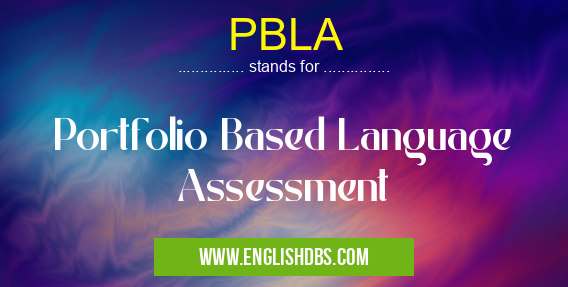What does PBLA mean in IMMIGRATION
PBLA stands for Portfolio-Based Language Assessment. It is a method of assessing language proficiency that emphasizes the collection and analysis of a learner's work over time. PBLA differs from traditional language assessments, which typically rely on a single, timed test.

PBLA meaning in Immigration in Governmental
PBLA mostly used in an acronym Immigration in Category Governmental that means Portfolio Based Language Assessment
Shorthand: PBLA,
Full Form: Portfolio Based Language Assessment
For more information of "Portfolio Based Language Assessment", see the section below.
PBLA Methodology
- PBLA involves the collection of a portfolio of language-related materials, such as writing samples, recordings, and artifacts.
- These materials are typically gathered over an extended period, allowing the learner to demonstrate their language skills in a variety of contexts.
- The portfolio is then evaluated by a qualified assessor who considers the learner's progress and overall language proficiency.
Benefits of PBLA
- Authenticity: PBLA allows learners to showcase their language skills in real-world contexts.
- Flexibility: PBLA can be tailored to meet the specific needs and goals of the learner.
- Validity: PBLA provides a comprehensive assessment of language proficiency by capturing a learner's skills over time.
- Reliability: The use of multiple assessment tools helps to ensure the reliability of PBLA results.
Applications of PBLA
- PBLA is commonly used in educational settings to assess language proficiency for students of all ages.
- It can also be used for professional development purposes, such as assessing language skills for job applicants or employees.
Essential Questions and Answers on Portfolio Based Language Assessment in "GOVERNMENTAL»IMMIGRATION"
What is PBLA?
PBLA (Portfolio Based Language Assessment) is a method of assessing language proficiency that utilizes a collection of student-selected artifacts to demonstrate their abilities in a target language.
What are the benefits of PBLA?
PBLA provides a comprehensive and authentic assessment of language skills by:
- Encouraging self-reflection and metacognition
- Promoting learner autonomy and motivation
- Providing evidence of language use in real-world contexts
What types of artifacts are typically included in a PBLA portfolio?
PBLA portfolios may include a variety of artifacts such as:
- Written assignments (essays, reports, poems)
- Oral presentations (speeches, videos, podcasts)
- Creative works (drawings, paintings, songs)
- Digital products (websites, blogs, apps)
How is PBLA evaluated?
PBLA portfolios are typically evaluated using a holistic rubric that considers factors such as:
- Language accuracy and fluency
- Vocabulary and grammar usage
- Cultural awareness
- Reflection and self-assessment
How does PBLA differ from traditional language assessments?
Traditional language assessments often focus on isolated skills, while PBLA emphasizes integrated language use and real-world communication. Additionally, PBLA promotes student ownership and involvement in the assessment process.
Is PBLA appropriate for all students?
PBLA is suitable for students of all levels and ages who are learning a target language. It can be adapted to meet the specific needs and goals of individual learners.
Final Words: PBLA is a valuable tool for assessing language proficiency that provides a more comprehensive and authentic measure of language skills compared to traditional assessments. It is a flexible and reliable method that can be tailored to meet the specific needs of learners in various settings.
